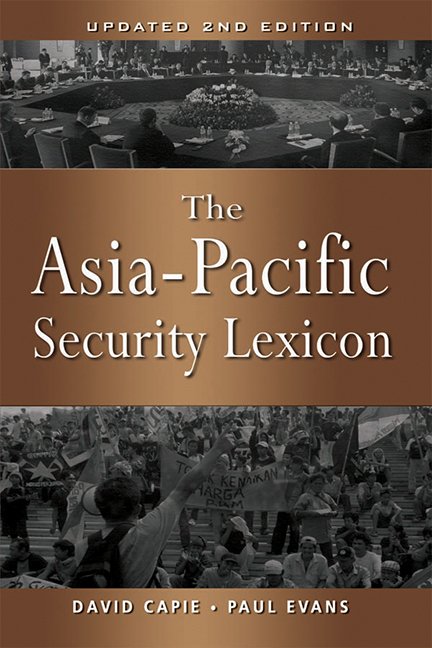Book contents
- Frontmatter
- Contents
- Abbreviations
- Introduction to the Second Edition
- Ad Hoc Multilateralism
- A la Carte Multilateralism
- The “ASEAN Way”
- Balance of Power
- Bilateralism
- Coalition of the Willing
- Coercive Diplomacy
- Collective Defence
- Collective Security
- Common Security
- Comprehensive Security
- Concert of Powers
- Concerted Unilateralism
- Confidence-Building Measures
- Confidence- and Security-Building Measures
- Constructive Intervention
- Cooperative Security
- Engagement
- Flexible Consensus
- Human Security
- Humanitarian Intervention
- Middle Power
- Multilateralism
- Mutual Security
- New Security Approach
- Non-Traditional Security
- Open Regionalism
- Peaceful Rise
- Pre-emption and Preventive War
- Preventive Diplomacy
- Security Community
- Terrorism
- Track One
- Track One-and-a-Half
- Track Two
- Track Three
- Transparency
- Trust-Building Measures
- About the Authors
Ad Hoc Multilateralism
Published online by Cambridge University Press: 21 October 2015
- Frontmatter
- Contents
- Abbreviations
- Introduction to the Second Edition
- Ad Hoc Multilateralism
- A la Carte Multilateralism
- The “ASEAN Way”
- Balance of Power
- Bilateralism
- Coalition of the Willing
- Coercive Diplomacy
- Collective Defence
- Collective Security
- Common Security
- Comprehensive Security
- Concert of Powers
- Concerted Unilateralism
- Confidence-Building Measures
- Confidence- and Security-Building Measures
- Constructive Intervention
- Cooperative Security
- Engagement
- Flexible Consensus
- Human Security
- Humanitarian Intervention
- Middle Power
- Multilateralism
- Mutual Security
- New Security Approach
- Non-Traditional Security
- Open Regionalism
- Peaceful Rise
- Pre-emption and Preventive War
- Preventive Diplomacy
- Security Community
- Terrorism
- Track One
- Track One-and-a-Half
- Track Two
- Track Three
- Transparency
- Trust-Building Measures
- About the Authors
Summary
Multilateralism created for “a particular or specific purpose.”1 Sometimes also called “single-issue multilateralism”, the term was used by Robert Scalapino to describe collaborative mechanisms developed to deal with specific security problems in Eastern Asia prior to the existence of a functioning regional security institution. In particular, the term has been used in Asia to describe multilateral responses to security problems on the Korean peninsula and in Cambodia.
Ad hoc multilateralism usually focuses on a single problem or issue and membership tends to be restricted to parties with a close link to the matter at hand. Scalapino's initial use of the term focused on North Korea's threat to withdraw from the Nuclear Non-Proliferation Treaty (NPT) during the first nuclear crisis. He argued that in the absence of a permanent peacemaking or peacekeeping institution in Northeast Asia, ad hoc multilateral arrangements limited to particular issue areas had to be organized to deal with the crisis. In the Korean case, this process involved complex shuttle diplomacy between the foreign ministers and leaders of the United States, Japan, China, and the two Koreas. It also included a key role for non-state actors including institutions such as the International Atomic Energy Agency (IAEA), the International Monetary Fund (IMF), and the Korean Peninsula Energy Development Organization (KEDO). Scalapino characterized the interactions between the parties as involving the construction of ad hoc arcs formed in concentric manner over a particular issue. He describes a series of interactions that take place among and between diverse parties, from the most essential to the more peripheral, but in each case stemming from a sense of national interest. In his view, arcs, not circles, represent the most appropriate metaphor since the different levels must be open-ended so that contact can be maintained among and between them.
Brian Job argues that ad hoc multilateralism should be seen as one end of a spectrum of possible multilateral arrangements.
- Type
- Chapter
- Information
- Publisher: ISEAS–Yusof Ishak InstitutePrint publication year: 2007

